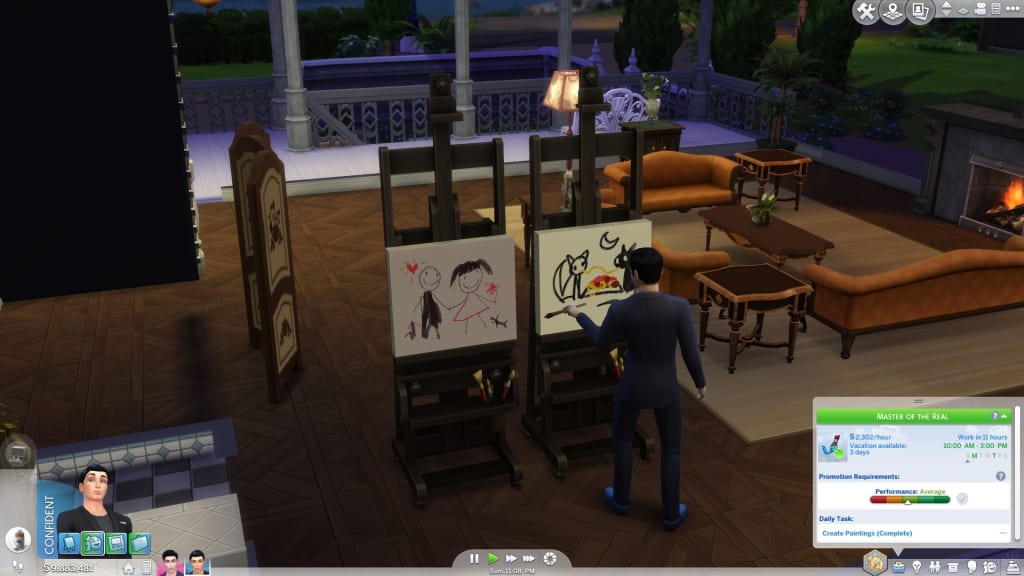The COVID Vaccine was NOT "Rushed"
Using Sims 4 to demonstrate the power of funding

You may have heard it from a friend or family member on social media: “I’m going to wait and let them test the vaccine on other people. I’m no guinea pig.”
There are plenty of sources of trepidation with the vaccine, but the primary source looks to be the timeline. The world identified the virus in January 2020 and had emergency authorization to vaccinate in December 2020. Shots were out and in people’s arms the next day.
I am hoping to demonstrate how this herculean effort was possible, and in order to do that, I want to use the example of The Sims.
For those who haven’t had the pleasure, The Sims is a simulation game in which players get to control virtual people and their surroundings. Like real life, Sims go to work, earn a paycheck, meet people, upgrade their homes, and try to be happy in whatever ways they can.
Sims begin with 20k “Simoleons” to buy a home and get started.

They work for 8 hours a day and bring home a modest paycheck which they use to pay bills, buy groceries, and maybe update their junk appliances. Players grind out the days until their Sims have the skills and network connections to earn promotions. Then they can afford their vacations and mansions.

Here’s the thing: most players don’t grind. They use cheats. Sims 4 cheats give players infinite money to buy anything they want and skip the grinding process. They skip straight to fulfillment.
How does this tie to vaccines? Simple. Project Warp Speed was the infinite money cheat.
Science projects, including vaccine research, is usually a slow and expensive process. Scientists apply for grants to fund their research for a certain number of years. The NIH is the main institute funding projects at public institutions. I’ve broken down the funding process here:

Note that scientists have to reapply for funding. Each year, we provide the NIH a progress report on our research results and ask for funding to continue research. If our results lag too much or produce poor results, the NIH can choose not to renew our funding. Grant applications can be extremely competitive with only 20.2% of applications succeeding in 2018, based on NIH data. Think of this as the ordinary grind in the field of research.
Compare that to “Operation Warp Speed”, a massive infusion of billions of dollars and government resources dedicated to one goal: 300 million safe and effective vaccines by January 2021. These projects had far more lee-way in their proposals and had access to excellent personnel and willing subjects.
Allow me to show my hand: I am a scientist at Binghamton University. We study addiction using animal models. Our laboratory is well-funded compared to others. We can afford a full-time technician, a part-time seasonal technician, four graduate students, a postdoctoral research scientist, a research specialist, and an administrative assistant. We pay about $5,000 for overhead costs to keep our animals happy and about $10,000 a month in research supplies.
If I had access to a real-life infinite money cheat, I would
- Hire 15 more full-time research technicians: 3 more for the 1st shift, 4 for 2nd shift, 4 for third shift, and 4 floaters
- Buy out the rest of our building’s facilities and pass them a stack of cash to ease any hard feelings
- Fill all of the animal holding rooms with research subjects
- Upgrade our animal housing. It’s very nice already - strawberry jams, bacon, toys, two kinds of chew blocks, pillow nests, saucer wheels - but with infinite money, we would give them even nicer pillows and wheels
- Hire two more veterinary technicians and another veterinarian for emergencies
- Upgrade our surgery suites with the best anesthesia machines
- Send my undergraduate students to Jackson Laboratories for surgery training
- Order all of the reagents and tools we’d need right away instead of bothering with purchase orders and spending limits
- A caterer in the breakroom with infinite sushi, pork chops, coffee, tea, and sodas…
The list can go on. It’s infinite money. Our research is only ever reasonably held back by funding, space, and time. If we didn’t need to constantly reapply for grants, and if we could have all the money we would want, our research would be done in six months. Instead, our projects stretch for a minimum of three years.
This is not always a bad thing. Many research projects lead to null results, and it’s better to invest in pilot projects and prototypes and find out that they’re duds than waste resources out of hand. Competition has its role in any field. As an animal researcher, I also benefit from the NIH’s oversight of all animal research; a large part of our grants are affirmations that our animals are treated well and that the research requires using mammals in the first place.
In comparison, Operation Warp Speed was able to:
- Hammer out all of their animal research at the top of the experiment
- Appeal to the public for volunteers
- Lean in on decades of research in mRNA vaccines completed in NIH-funded research
- Access the best scientists with knowledge of protocols from across the field
In conclusion, much like a Sim, research becomes far more productive and fulfilling once money is no longer an obstacle. The vaccines produced by our real-life infinite money cheat were not rushed. They were extremely well-funded.





Comments
There are no comments for this story
Be the first to respond and start the conversation.